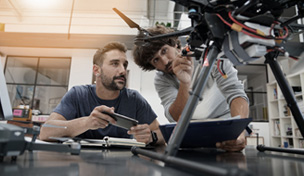Keywords: Athletic Safety
Market Overview
This novel faceguard test determines the structural stiffness for all newly manufactured facemasks, serving to reduce head injuries among athletes due to the use of inadequately performing protective gear. In response to the high rate of severe traumatic brain injury and skull fracture during football play, in 1974 the National Operating Committee for the Standards of Athletic Equitment (NOCSAE) developed a safety protocol to evualuate football helmets. The standard for assessing the faceguard component of these helmets has been largely unaltered since then. Clemson Headgear Impact Performance Lab (CHIP) testing has demonstrated that the current apparatus is ineffective in evaluating the performance of the facemask at the design, structural, or material levels. The current test also destroys the facemask, rendering it unusable. Clemson researchers have developed a novel method and apparatus for testing faceguard effectiveness, without destroying the facemask, developing parameters that more accurately reflect the impact and strain the faceguard undergoes during sporting activities.
John DesJardins
Gregory Batt
2018-031
Applications:
Athletic Equipment, Protective Headgear, Facemask, Faceguard, Athlete Safety
Technical Summary:
This technology comprises four main improvements over the existing NOCSAE stiffness apparatus and test. First, the CHIP test allows for a degree of lateral and rotational movement of the facemask during testing, as well as reducing the load applied to the facemask. Combined, these two factors reduce the likelihood of permanent damage to the mask during testing. Furthermore, the load is applied using a 6” diameter plunger, as opposed to a 1”, and the deformation of the mask is limited to 5mm from 3 inches. These factors reduce the likelihood of permanent facemask damage, and also achieves the goal of generating data spanning a spectrum of differences across facemask design.
Advantages:
• Allows for lateral and rotational facemask movement, reducing permanent deformation of the facemask
• Applies a load to the facemask at 100mm/min, reduced from 254 mm/min, ensuring the facemask does not splinter or break during testing
• Uses a 6” diameter plunger to apply force to the facemask, ensuring a broader distribution of force that allows for greater nuance of measurement
Technology Overview
State of Development
Testing
Patent Type
Provisional
Category
Serial Number
62/747,510
CURF Reference No.
2018-031
Inventors
John DesJardins, Gregory Batt
For More Info, Contact:
Interested in this technology?
Contact curf@clemson.edu
Please put technology ID in subject line of email.
Contact
Latest News from CURF
Stay up-to-date with the latest trends in the innovation and research industry. Sign up for our newsletter to see how CURF is making a difference and impacting the economy where we live.









